AP Art: Abstract Expressionism Ch. 9
1/46
There's no tags or description
Looks like no tags are added yet.
Name | Mastery | Learn | Test | Matching | Spaced |
|---|
No study sessions yet.
47 Terms
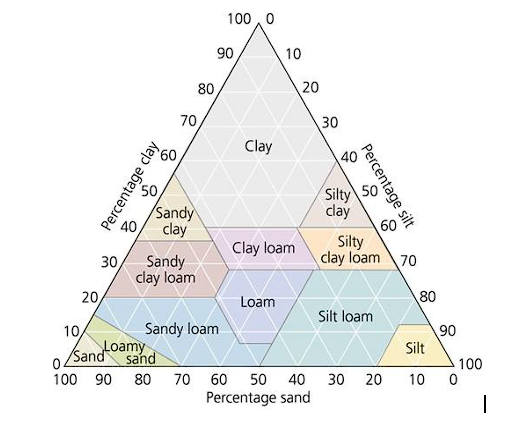
1) This pyramid depicts soil ________.
A) profiles
B) nutrient content
C) horizons
D) textures
E) parent materials
D) textures
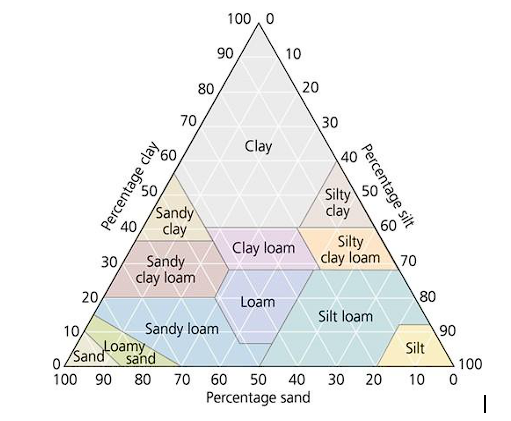
2) Soil that is 50% clay, 20% silt, and 30% sand would be categorized as ________.
A) silty clay
B) clay
C) loam
D) clay loam
E) silty sandy clay
B) clay
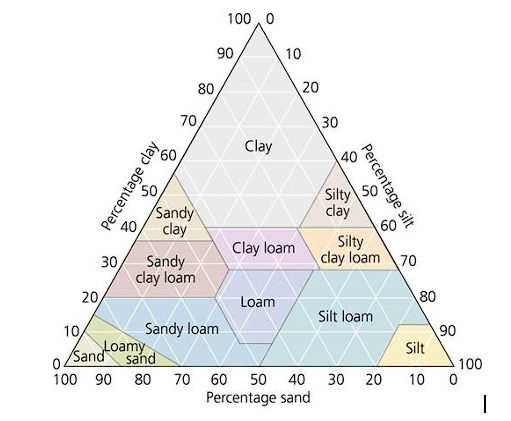
3) What is the approximate minimum percent sand a soil can have and still be considered "sandy loam"?
A) 55%
B) 85%
C) 20%
D) 28%
E) 43%
E) 43%
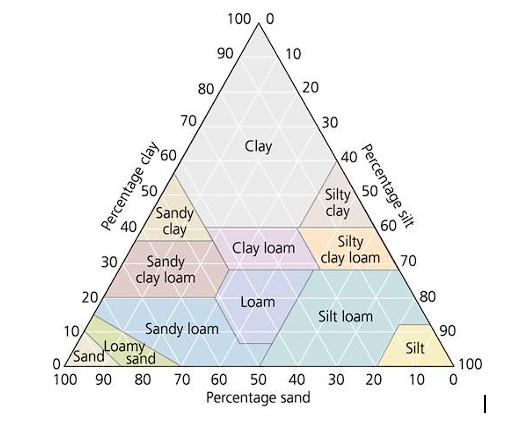
4) Soil that is 30% silt could be classified as any of the following EXCEPT ________.
A) loam
B) clay loam
C) sandy loam
D) clay
E) silt loam
E) silt loam
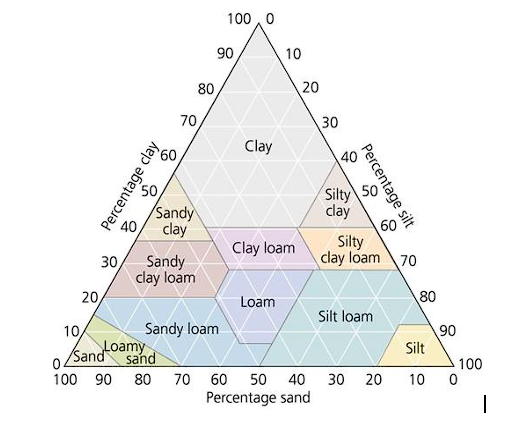
5) Which of the following soils would be classified as clay loam?
A) 60% clay, 70% sand, and 30% silt
B) 30% clay, 40% sand, and 30% silt
C) 70% clay, 10% silt, and 20% sand
D) 70% silt and 30% sand
E) 60% clay and 40% silt
B) 30% clay, 40% sand, and 30% silt
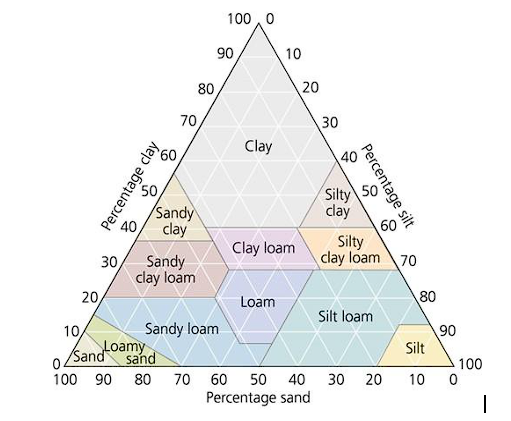
6) Soil classified as sand is ________% sand.
A) 100
B) at least 70
C) at least 43
D) at least 85
E) at least 10
D) at least 85
1) Humus is ________.
A) an artificial fertilizer applied to monocultures
B) the organic soil component that holds soil moisture and enhances soil fertility
C) the layer sometimes found in a soil horizon that is created by eluviation; it causes serious problems in agricultural fields
D) caused by agricultural runoff into waterways or into the water table
E) one of the primary causes of desertification if it is present in excess
B) the organic soil component that holds soil moisture and enhances soil fertility
2) Overgrazing can result in all of the following EXCEPT ________.
A) the proliferation of weeds
B) soil compaction
C) soil erosion
D) increased water infiltration
E) desertification
D) increased water infiltration
3) We lose 5 to 7 million hectares of productive cropland per year to ________.
A) forest replanting and regeneration
B) soil degradation
C) recreational land use
D) soil conservation efforts
E) abandonment, feralization, and other factors
B) soil degradation
4) Monoculture farming ________.
A) is typical of Native American farming techniques
B) is always accompanied by no-till agriculture
C) requires no chemical fertilizers or pesticides
D) is a development of industrial agriculture
E) accounts for less than 1% of U.S. croplands
D) is a development of industrial agriculture
5) Tommy and Teagan are learning the process of good home gardening and decide to help their parents as best as they can. Every day they walk along rows of bean plants, carefully inspecting each plant for harmful insects, and removing any that they find. However, the bean plants do not grow well, and few beans form. Their parents notice the poor beans, inspect the plants and soil, and tell the children that walking around the plants every day has hurt the plants by ________.
A) compacting the soil, decreasing aeration and infiltration
B) increasing soil aeration and killing soil microorganisms
C) reducing the nutrient minerals in the soil
D) converting the topsoil into clay
E) contaminating the soil with toxins leaching from their shoes
A) compacting the soil, decreasing aeration and infiltration
6) Leaching and the rate of movement of water would be greatest in a soil classified as ________.
A) clay
B) silt
C) sand
D) organic
E) hypersaline
C) sand
7) Until about 10,000 years ago, our species depended on ________.
A) crops
B) hunting and herding
C) cattle and goats
D) crops and cattle
E) hunting and gathering
E) hunting and gathering
8) ________ refers to the agricultural practices in which the members of a farming family produce only enough food for their family's own subsistence and do not make use of large-scale irrigation, chemical fertilizer, or machinery and technology.
A) Traditional agriculture
B) Subsidence agriculture
C) Postindustrial agriculture
D) Advanced organic farming
E) Reduced tillage agriculture
A) Traditional agriculture
9) Industrial agriculture ________.
A) had no impact on agriculture
B) is necessary today for all cultures
C) increased our ability to obtain more food from the same area
D) permanently improved soils, providing more food from less space
E) rapidly deteriorated soils, requiring continuous movement to new croplands
C) increased our ability to obtain more food from the same area
10) Factors involved in soil formation include ________.
A) nitrogen-fixing bacteria and grazing by herbivores
B) erosion, level terrain, and the absence of rooted vegetation
C) weathering of parent material and the addition of organic material
D) tropical climate, acid precipitation, and frequent wildfires
E) seasonal changes in the tides
C) weathering of parent material and the addition of organic material
11) A soil deficient in humus would have ________.
A) a very low mineral content
B) no cations
C) many decomposers and be able to hold considerable moisture
D) a large amount of vegetative detritus at the surface
E) very low levels of biological activity
E) very low levels of biological activity
12) The breakdown of large rocks into smaller pieces is ________.
A) called mineralization
B) affected by rainfall, freezing, and thawing
C) unaffected by winds
D) a major cause of topsoil erosion
E) primarily caused by topsoil erosion
B) affected by rainfall, freezing, and thawing
13) Leaching ________.
A) can help plant growth only if done properly
B) is caused by movement of water upward through soil from the water table
C) adds nutrients to soil naturally
D) removes water-soluble nutrients from topsoil
E) is a common agricultural practice to improve soil
D) removes water-soluble nutrients from topsoil
14) The O horizon is ________.
A) composed primarily of bedrock
B) composed of equal amounts of bedrock and organic material
C) primarily loam
D) usually more sand than silt or clay
E) primarily composed of organic materials
E) primarily composed of organic materials
15) The horizon where leached minerals and organic matter accumulate is called the ________.
A) O horizon
B) B horizon
C) C horizon
D) E horizon
E) parent material
B) B horizon
16) Most rangeland in the U.S. is managed by ________.
A) private ranchers
B) the Environmental Protection Agency
C) the Bureau of Land Management
D) the Department of Rangeland Management
E) the Conservation Reserve Program
C) the Bureau of Land Management
17) Compaction of soil in a garden harms plants by ________.
A) increasing aeration, decreasing infiltration, and increasing runoff
B) decreasing aeration, decreasing infiltration, and increasing runoff
C) increasing aeration, increasing infiltration, and decreasing runoff
D) decreasing aeration, increasing infiltration, and decreasing runoff
E) increasing the amount of clay, decreasing the amount of silt, and decreasing infiltration
B) decreasing aeration, decreasing infiltration, and increasing runoff
18) pH influences ________.
A) plant growth
B) erosion
C) soil compaction
D) the number of soil horizons
E) soil clumpiness
A) plant growth
19) Soil texture refers to the relative amounts of ________ in soil.
A) detritus and humus
B) organic matter and minerals
C) sand, silt, and clay
D) water, organic matter, and minerals
E) mineral content and water saturation
C) sand, silt, and clay
20) ________ is the loss of more than 10% of soil productivity in arid areas due to such factors as erosion, soil compaction, overgrazing, and forest removal.
A) Climatization
B) Alkalinization
C) Desertification
D) Salinization
E) Stratification
C) Desertification
21) ________ is the federal agency responsible for preventing soil erosion and protecting waterways in agricultural areas of the United States.
A) Soil and Water Conservation Service
B) Agricultural Standards Agency
C) Agricultural Conservation Service
D) Soil Degradation Minimization Service
E) Natural Resources Conservation Service
E) Natural Resources Conservation Service
22) Shelterbelts are to ________ as terraces are to ________.
A) wind erosion; water erosion
B) water erosion; wind erosion
C) leaching; desertification
D) stratification; salinization
E) salinization; stratification
A) wind erosion; water erosion
23) ________ is the buildup of salts in soils, often as a result of overirrigation.
A) Salinization
B) Leaching
C) Weathering
D) Erosion
E) Evaporation
A) Salinization
24) Decomposers are most likely found in the ________.
A) E and B horizons
B) A and O horizons
C) B and C horizons
D) C and E horizons
E) C and R horizons
B) A and O horizons
25) Researchers at the Malpai Borderlands in southern New Mexico and Arizona have found evidence that ________.
A) ancient nomadic tribes permanently altered the landscape by settling down and ranching in one area
B) fire suppression has played a major role in the degradation of the rangeland in the area
C) ranchers have been planting mesquite to replace lost grasslands
D) desertification has resulted in soil compaction and erosion
E) the region cannot sustain any level of commercial ranching
B) fire suppression has played a major role in the degradation of the rangeland in the area
26) The results of the overapplication of fertilization can include ________.
A) very large fruits and vegetables
B) eutrophication in nearby waters
C) large crop yields per acre
D) crops spreading rapidly into nearby areas
E) very fertile soils in future years
B) eutrophication in nearby waters
27) The Conservation Reserve Program pays farmers to ________.
A) grow native crops such as corn and beans
B) stop cultivating highly erodible cropland
C) grow cattle feed instead of commercial crops
D) stop growing tobacco
E) grow soybeans and other kinds of harvestable groundcover
B) stop cultivating highly erodible cropland
28) Planting ________ between other crops will help replace depleted soil nitrogen.
A) corn
B) legumes
C) wheat
D) trees
E) pineapples
B) legumes
29) Grasses and conifer trees are pollinated by ________.
A) bees and wasps
B) water
C) ants
D) flies
E) the wind
E) the wind
30) Erosion can result in a positive feedback loop because ________.
A) rainwater increasingly soaks into the ground
B) the accumulation of humus makes erosion more likely
C) plants are less likely to grow in eroded soil
D) the pH of the soil increases as erosion continues
E) greater weathering of parent material will occur
C) plants are less likely to grow in eroded soil
31) No-till farming would be most beneficial for farmers ________.
A) with steeply sloped fields
B) who plant a cash crop every third year
C) who typically experience minimal soil erosion
D) using contour strip cropping
E) whose cropland is in the Conservation Reserve Program
A) with steeply sloped fields
32) Irrigation can result in the salinization of soils because ________.
A) shortages of fresh water require the use of saltwater for irrigation
B) irrigation is typically used in areas where windblown salts from sea spray can accumulate when the protective vegetation is removed
C) the irrigation water washes away soil leaving behind concentrated salts
D) many of the plants grown in these regions excrete salts into the soil
E) salts in the water are deposited on the soil surface as water evaporates
E) salts in the water are deposited on the soil surface as water evaporates
33) Which of the following is pollinated by bees?
A) corn
B) alfalfa
C) wheat
D) switchgrass
E) pine trees
B) alfalfa
34) Inorganic fertilizers are ________.
A) less likely to leach from soil than organic fertilizers
B) are either mined or manufactured
C) applied to cropland in the form of manure and compost
D) less likely to be used on cropland today than they were 100 years ago
E) used in place of organic fertilizers by farmers who are concerned about surface water and groundwater pollution
B) are either mined or manufactured
35) Drip irrigation is ________.
A) more likely to result in soil salinization than other irrigation techniques
B) more than twice as efficient at conserving water as traditional conventional irrigation
C) only half as efficient at conserving water as center-pivot irrigation
D) typically used in combination with flood-and-furrow irrigation
E) used in aquaculture
B) more than twice as efficient at conserving water as traditional conventional irrigation
36) All of the following were steps toward sustainability taken by Kennesaw State University EXCEPT ________.
A) going trayless in their cafeteria
B) building a LEED-certified commons
C) producing their own food
D) constructing their own nuclear power plant
E) beginning a recycling and composting program
D) constructing their own nuclear power plant
Long ago, two sisters were talking as they returned from their morning trip to collect mushrooms, seeds, berries, and green leaves for the day's meals. The younger woman was watching the progress of a small rabbit as it hopped across the path and toward the clan's trash midden (refuse heap), where broken tools (made of bone, stone, or shell) were tossed, and where discarded food was thrown. She noticed the rabbit stop and begin nibbling at the many new, green shoots sprouting across one side of the midden. She walked over to look, and she saw that some of last year's discarded dried fruits were growing. Surprised and interested, she called her sister over to discuss this find.
1) This is the story of a group whose food ________.
A) is supplied by subsistence gardening
B) is raised in a form of primitive agriculture
C) is traded between tribes for variety
D) is supplied by hunters
E) is supplied by hunters and gatherers
E) is supplied by hunters and gatherers
Long ago, two sisters were talking as they returned from their morning trip to collect mushrooms, seeds, berries, and green leaves for the day's meals. The younger woman was watching the progress of a small rabbit as it hopped across the path and toward the clan's trash midden (refuse heap), where broken tools (made of bone, stone, or shell) were tossed, and where discarded food was thrown. She noticed the rabbit stop and begin nibbling at the many new, green shoots sprouting across one side of the midden. She walked over to look, and she saw that some of last year's discarded dried fruits were growing. Surprised and interested, she called her sister over to discuss this find.
2) It is probably TRUE that ________.
A) until now, this group had not considered hunting
B) until now, this group had not considered deliberately planting seeds
C) this group already has a good agricultural system
D) this group was living in a village they had established many years earlier
E) this group was quite large
B) until now, this group had not considered deliberately planting seeds
Long ago, two sisters were talking as they returned from their morning trip to collect mushrooms, seeds, berries, and green leaves for the day's meals. The younger woman was watching the progress of a small rabbit as it hopped across the path and toward the clan's trash midden (refuse heap), where broken tools (made of bone, stone, or shell) were tossed, and where discarded food was thrown. She noticed the rabbit stop and begin nibbling at the many new, green shoots sprouting across one side of the midden. She walked over to look, and she saw that some of last year's discarded dried fruits were growing. Surprised and interested, she called her sister over to discuss this find.
3) These women likely lived ________.
A) about 100 to 300 years ago
B) about 1000 to 2000 years ago
C) about 10,000 years ago
D) at least 200,000 to 250,000 years ago
E) at least 500,000 years ago
C) about 10,000 years ago
Long ago, two sisters were talking as they returned from their morning trip to collect mushrooms, seeds, berries, and green leaves for the day's meals. The younger woman was watching the progress of a small rabbit as it hopped across the path and toward the clan's trash midden (refuse heap), where broken tools (made of bone, stone, or shell) were tossed, and where discarded food was thrown. She noticed the rabbit stop and begin nibbling at the many new, green shoots sprouting across one side of the midden. She walked over to look, and she saw that some of last year's discarded dried fruits were growing. Surprised and interested, she called her sister over to discuss this find.
4) The next step in this story would likely be that this woman and her sister ________.
A) began to deliberately plant seeds near their village to make food gathering easier in the future
B) began to seek out old middens to find and eat the things growing there
C) began to trade seeds with people from other villages
D) began to save, sort, and name different types of seeds
E) started a full-scale garden, digging the soil and enriching it with food wastes
A) began to deliberately plant seeds near their village to make food gathering easier in the future
Long ago, two sisters were talking as they returned from their morning trip to collect mushrooms, seeds, berries, and green leaves for the day's meals. The younger woman was watching the progress of a small rabbit as it hopped across the path and toward the clan's trash midden (refuse heap), where broken tools (made of bone, stone, or shell) were tossed, and where discarded food was thrown. She noticed the rabbit stop and begin nibbling at the many new, green shoots sprouting across one side of the midden. She walked over to look, and she saw that some of last year's discarded dried fruits were growing. Surprised and interested, she called her sister over to discuss this find.
5) Twenty years have passed since the young woman first noticed seeds sprouting in the midden. Which of the following could now be TRUE?
A) The group had been sedentary but was now nomadic, looking for good places to settle for a season and grow crops.
B) The group had been traders in stone tools and were now traders in simple agricultural implements and seeds.
C) The group had been quite large and ate a great deal of meat, but there were now fewer of them since their diet consisted mostly of vegetables.
D) The group had been nomadic, moving frequently to gather wild foods and hunt, but are now more sedentary, growing crops.
E) The group had been very warlike and were now more peaceful, tending their lands.
D) The group had been nomadic, moving frequently to gather wild foods and hunt, but are now more sedentary, growing crops.